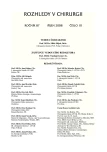Use of Allogenous Material in the Management of Spina Bifida Aperta
Authors:
P. Omaník; F. Horn; M. Smrek; I. Béder; E. Murár; J. Trnka; V. Cingel
Authors‘ workplace:
Klinika detskej chirurgie DFNsP a LF UKo, Bratislava, Slovenská republika, prednosta: MUDr. Ján Trnka, CSc.
Published in:
Rozhl. Chir., 2008, roč. 87, č. 10, s. 527-530.
Category:
Monothematic special - Original
Overview
Aim:
“Conditio sine qua non“ in the management of open neural tube defects includes closure of all layers with as minimum as possible tension left within the suture region, in order to prevent early, as well as long-term postoperative complications. In extensive fascial defects, the authors used the Gore-Tex patch as an alternative to myofascial or fasciocutaneous flaps.
Patients and Methods:
From January 2004 to January 2008, 23 patients suffering from open spina bifida underwent surgery in the Bratislava Pediatric Surgery Centre. In 17 subjects, the fascia was sutured following a myofascial release, in 2 subjects the suture was secured with tissue adhesive. In 4 subjects, the Gore-Tex patch was implanted to secure the „tension free“ plasty; the Gore-Tex Dual Mesh was used in 2 subjects as well as the Gore-Tex Spinal.
Results:
Two subjects, who had the Gore-Tex Dual Mesh implanted, developed sequestration of the implant during the late postopertive period. Upon reoperation, the authors removed the Gore-Tex Dual Mesh in the both subjects. However, they found a firm fibrous membrane, which was considered sufficient to protect the dural sac. On the contrary, the both subjects who had the Gore-Tex Spinal implanted, healed with no complications recorded.
Conclusion:
Based on the experience, the Gore-Tex Dual Mesh, although implanted lege artis, does not appear a suitable material for fascia replacements in open spina bifida plastic procedures. Further experience will give more evidence, whether Gore-Tex Spinal would be a suitable alternative, however, the courses in the 2 subjects have hitherto been encouraging.
Key words:
neural defects – spina bifida, Gore-Tex – reconstruction/plasty – complications
Sources
1. Behunová, J., Podracká, Ľ. Rázštepy nervovej trubice – súčasné pohľady na etiopatogenézu a možnosti prevencie kyselinou listovou. Česko-slovenská pediatrie, 2008, roč. 63, s. 38–46.
2. Šabová, L., Kovács, L. Kyselina listová a vrodené vývojové chyby. Pediatria pre prax, 2008, roč. 1, s. 36–38.
3. Aliredjo, R. P., de Vries. J., Menovsky, T., Grotenhuis, J. A., Merx, J. The use of Gore-Tex membrane for adhesion prevention in tethered spinal cord surgery: technical case report. Neurosurgery, 1999, Vol. 44, s. 674–677.
4. Inoue, H. K., Kobayashi, S., Ohbayashi, K., Kohga, H, Nakamura, M. Treatment and prevention of tethered and retethered spinal cord using a Gore-Tex surgical membrane. Journal of Neurosurgery, 1994, Vol. 80, s. 689–693.
5. Keller, J. T., Weil, S. M., Ongkiko, C. M., Tew, J. M., Mazfield, F. H., Dunsker, S. B. Repair of spinal dural defects with vicryl (polyglactin 910) mesh. Journal of Spinal Disorders, 1989, Vol. 2, s. 87–92.
6. Meddings, N., Scott, R., Bullock, R., French, D. A., Hide, T. A., Gorham, S. D. Collagen vicryl – a new dural prosthesis. Acta Neurochirurgica, 1992, Vol. 117, s. 53–58.
7. Park, Y. K., Tator, C. H. Prevention of arachnoiditis and postoperative tethering of the spinal cord with Gore-Tex surgical membrane: an experimental study with rats. Neurosurgery, 1998, Vol. 42, s. 823–824.
8. Baglaj, M., Ladogórska, J., Rysiakiewicz, K. Closure of large myelomeningocoele with Ramirez technique. Childs Nervous System, 2006, roč. 22, s. 1625–1629.
9. Fiala, T. G., Buchman, S. R., Muraszko, K. M. Use of lumbar periosteal turnover flaps in myelomeningocele closure. Neurosurgery, 1996, Vol. 39, s. 522–525.
10. Ramasastry, S. S., Cohen, M. Soft tissue closure and plastic surgical aspects of large open myelomeningoceles. Neurosurgery Clinics of North America, 1995, Vol. 6, s. 279–291.
11. Horn, F. Spina bifida. Kaudálne defekty neurálnej rúry. Prešov: Vydavateľstvo Michala Vaška, 2005. 96 s.
12. Smrek, M., Pekarovič, E., Vidiščák, M., Cingel, V., Horn, F. Tethered cord syndrome. Česko-slovenská pediatrie, 1997, Supl. 1, roč. 52, s. 32.
13. Dragula, M. Rážštepy neurálnej trubice. In: Zibolen, M. a spol. Praktická neonatológia. Martin: Neografia, 2001, s. 212–216.
Labels
Surgery Orthopaedics Trauma surgeryArticle was published in
Perspectives in Surgery

2008 Issue 10
- Metamizole vs. Tramadol in Postoperative Analgesia
- Metamizole at a Glance and in Practice – Effective Non-Opioid Analgesic for All Ages
- Spasmolytic Effect of Metamizole
Most read in this issue
- Treatment Strategy in Non-Parasitic Benign Cysts of the Liver
- Carcinoma of the Gallbladder – Current Surgical Treatment Options
- Later Age Diaphragmatic Hernia
- Acute Scrotum is a Condition Requiring Surgical Intervention
